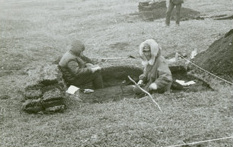Ipiutak Site | |
 Excavating the Ipiutak Site | |
| Location | Address restricted [1] |
|---|---|
| Nearest city | Point Hope, Alaska |
| NRHP reference No. | 66000157 [2] |
| AHRS No. | XPH-003 |
| Significant dates | |
| Added to NRHP | October 15, 1966 |
| Designated NHL | January 20, 1961 [3] |
The Ipiutak Site is a large archaeological site at Point Hope in northwest Alaska, United States. It is one of the most important discoveries in this area, competing only with Ekven, Russia[ citation needed ].
It is the type site for the Ipiutak culture, which arose possibly as early as 100–200 BCE and collapsed around 800 CE. The Ipiutak culture occurred from south of the Bering Strait, across the Brooks Range and possibly as far north as Point Barrow.
The Ipiutak Site was discovered in 1939 by archaeologists Helge Larsen and Froelich Rainey, who completed a monograph on the site in 1948. The site consists of nearly 600 abandoned house depressions along four beach ridges that impart a linearity that was originally interpreted as purposeful design as roads or "avenues." Many of the houses are too close to be contemporaneous and the range of several radiocarbon ages suggests a duration of 300–400 years to build all of the houses. Archaeologists have modeled the population history of the site to infer that only about 125–200 people lived at the site during any one generation and occupied 20 to 30 houses. The original population estimates of over 4000 are in error.
Excavations in 1940 and 1941 produced sizable collections from 74 square driftwood constructed houses and over 120 burials, now archived within three museums: the National Museum of Denmark, the American Museum of Natural History and the University of Alaska Fairbanks. The winter houses had a foundation sized from 3 by 3 meters to 6 by 7 with rounded corners. [4] Every house had a raised wooden floor made from logs resting on gravel, and a fireplace. [4] Ipiutak houses contain evidence of military and craft specialization in working walrus tusk, while a number of graves show evidence of violence associated with warfare.
The graves at Ipiutak can be divided into coffin and shallow burials: the deeper graves contain log coffins typically with one body (but sometimes more) and are about 50 cm below the ground, while the shallow burials may have been not dug at all, with the bodies placed into wooden frames and left at the surface. [4]
The site is renowned for its mortuary offerings, two of which were termed masks. Both of them are composite objects that had wooden backings, which were lost. [4] One Point Hope Ipiutak mask represents a human face with facial tattoos, a gaping mouth and blowfly larvae issuing from its nostrils; the symbolism of these markings is not known for certain: one possibility is a shamanistic meaning connected with Inuit myths about worms; another is an emulation of parasite-infested caribou. [4] A very similar "maskoid" is reported from Deering, that is dated between 600 and 800 CE. The other mask is smaller and found in a coffin with a man, a woman and a child; the mark was placed on the child's chest. [4] This mask has cheek and lip plugs as well as 14 ivory pendants with carved representation of animals. [4] Several mouth masks have also been found in the graves. [4]
A variety of open work ivory carvings, engraved with iron burins, are renowned for their figurative representations that include polar bears, loons, seals, and (rarely) humans. Almost all of the ivory carvings are found in the shallow burials. [4]
Two technological hallmarks of Ipiutak culture are its very finely crafted stone tools used in arrow points and its lack of ceramics. The Ipiutak culture is defined by a distinctive linear, circle and dot aesthetic, that closely resembles the Old Bering Sea culture, which is restricted to Bering Strait and adjacent Siberia. Ipiutak is contemporaneous with the later phases of Old Bering Sea and very likely had had political, economic and social ties with it. The original excavators, Larsen and Rainey, linked the Ipiutak open work animal carving style with the distant and Scthyo-Siberian cultures of Ukraine, but little data support this supposition. Instead, Ipiutak closely resembles the widespread pan Alaska Norton culture, which did use ceramics and relied on salmon fishing. The subsistence basis of Ipiutak was sea mammal hunting, most importantly of ringed seal and walrus, although caribou hunting was also crucial.
The site was declared a National Historic Landmark in 1961 [3] and was added to the National Register of Historic Places in 1966. [5]
Several other sites have also been linked to Ipiutak: at Cape Krusenstern, Itivlik Lake, Hahanudan Lake, Feniak Lake, Onion Portage Archeological District, Deering. Point Spencer and Anaktuvuk Pass, Alaska. [4] The culture is noted for the elaborateness of its artwork, which seems to be an ancestor of Inuit art. It is still unclear why the Ipiutak apparently did not hunt whale or make pottery, considering that they lived in highly developed settlements. [6] [7] [4] [8]

